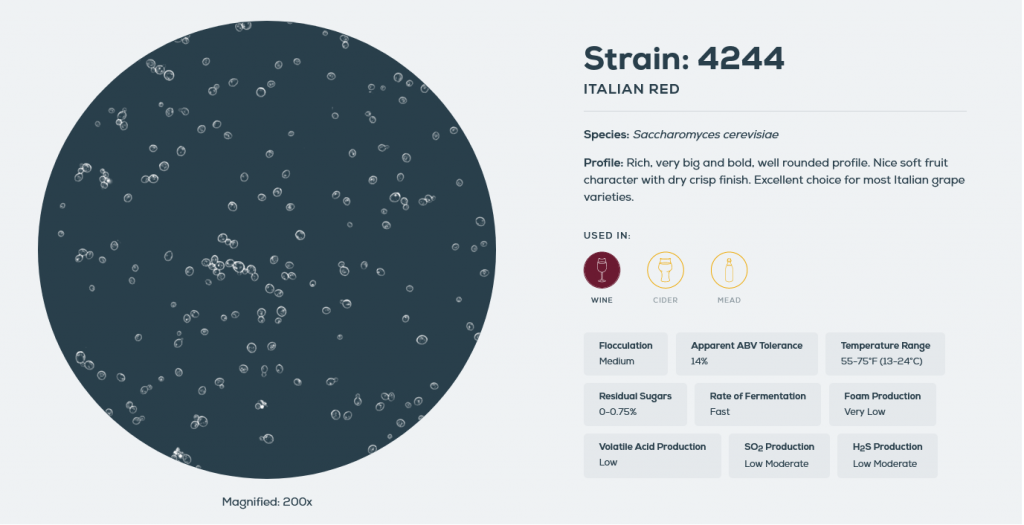CHOOSING YEAST FOR WINE MAKING
Yeast and Why is It Important in Wine Making
What is Yeast?
It is a single-celled organism. This single-celled organism is a fungus that gets its energy from the consumption of sugar or starch. It transforms sugar and starch into alcohol and Carbon Dioxide (CO2). This makes yeast a sugar fungus.
Yeast exists naturally in all areas of the world. It exists on flowers and fruits because they contain lots of sugar. It exists in the oceans in seaweed, seawater, fish and mammals. It exists on humans as skin flora and in our gastrointestinal tract where it helps us avoid issues such as diarrhea and infections.
How Do We Know Yeast Exits
Since man existed, we have been taken advantage of naturally occurring or wild yeast without realizing it. 1500 types of wild yeast have been identified so far with many more probably to be discovered. For thousands of years, people have been amazed that if left alone long enough fruit juice will start to bubble and become a complex and intoxicating drink. However, there was no idea as to how this happened. In the Middle Ages, some of the bubbling froth that occurred on fruit juices was skimmed off to help start the next batch of juice. It was known as “goddes god” or God’s gift. It wasn’t until 1680 that Antonie van Leeuwenhoek was the first person to see yeast organisms by way of the lenses he developed. About 200 years later, Louis Pasteur predicted that yeast was responsible for fermentation and that different yeasts could create different flavors in wine from the same grape. The first yeast cultures used to create wine occurred in 1890 and was accomplished by Herman Müller by isolating pure strains of yeast.
How to Choose Yeast for Wine
The first decision is whether to use wild yeast or commercial yeast strains. The use of wild yeast has been a debatable topic for some time now. The downside with using wild yeast is that it is unpredictable as to the resulting wine. The fermentation can become “stuck” (stop before it is completed) which can be a disaster. The vintner cannot be sure as to what wild yeasts are involved in the fermentation process. Wild yeasts could be from within the winery, from the grapes or in the air. The fermentation must be closely monitored to ensure that it completes and no negative characteristics appear such as off odors and undesirable flavors. The vintner is also unsure what flavors will come from the wild yeast and what structural changes could occur. However, vintners who use wild yeasts say that these yeasts often create complexity in the wine. If the fermentation does become “stuck”, vintners will fall back on commercially developed yeast to try to complete the fermentation.
There are currently more than 200 commercial yeast strains for winemaking. The main advantage to using commercial yeast strains is the fact that it almost guarantees a complete fermentation. It is less likely that a “stuck” fermentation will occur. Commercial yeast strains can accurately predict such wine characteristics as nice fruity aromas, a high level of alcohol, an attractive mouth texture and an ability to ferment in low temperatures or high acid. Other characteristics of commercial yeast strains are low foaming during fermentation and some produce sediment that settles quickly. Commercial yeast strains have been developed for specific grapes and grape types such as red wines, white wines, fruit forward wines, Italian wines, etc. The last key point is that using a commercial yeast, ensures the yeast fermentation starts rapidly, and that a single strain dominates the entire fermentation so that if other wild strains are present, they cannot get a foothold and produce off flavors or negative characteristics like rotten egg smells.
My Preference
I have never used wild yeasts so I cannot provide any results from practical experience. I have always used commercially developed yeast strains and have always had successful fermentations. I have made wine from fruit, grapes and juice with commercial strains with equal success. I now make wine from juice from California, Washington, and New York in the United States. I also make wine from imported juice from Italy, Chile, and South Africa. To choose the yeast strain I am going to use for a particular juice, I first research thoroughly what yeast strains have been used to produce that wine. I have even gone as far as to contact a vineyard to discuss the production of a particular wine with the vintner. For an example, I contacted a vineyard in South Africa when I was making a batch of Pinotage. I drank a Pinotage that I really enjoyed and contacted the vineyard that produced it. The vintner was more than happy to talk with me, and we spent about a half hour discussing Pinotage. He provided to me the yeast strain they used but it was not available in the U.S. He then pointed me to a strain that had similar characteristics that was available in the U.S. The Pinotage I produced came out with the expected characteristics and was very enjoyable.
In Conclusion
I prefer to use commercially developed strains of yeast, but many vintners swear by the use of wild yeasts. If you are making small batches of wine up to 25 gallons and want to be sure your fermentation will complete successfully and there are certain characteristics you want the wine to have, I suggest the use of commercially developed yeasts.

